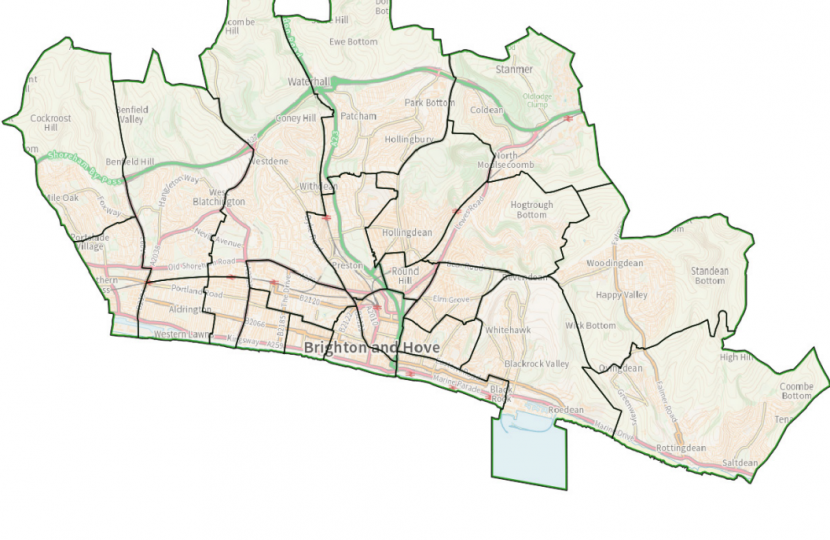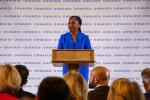
2023 will see new ward boundaries come into effect at Brighton and Hove City Council for the first time in 20 years, following the completion of a statutory review by the Local Government Boundary Commission for England.
The changes will be taking effect for the 2023 City Council elections, to be held on May 4th.
Local ward boundaries are important to residents and carry great meaning as they define their local community and are used to elect their local councillors. For example in my ward of Woodingdean, residents are proud to retain their local 2-councillor Woodingdean ward on the city council and to have the village represented as a whole on the issues that impact them.
Wards are meant to reflect complete communities of interest; ensure convenient and effective local representation for residents via the election of local councillors; and provide a degree of electoral equality, ensuring each ward councillor elected represents roughly the same number of electors. In Brighton and Hove each ward is elected by 2 or 3 councillors.
Ward boundaries are also used as the building blocks of Parliamentary Constituencies, when these are reviewed every few years. They are often used to gather and compare statistics between communities.
Their importance means that there is always plenty of interest from residents and community groups when ward boundaries are redrawn, and this is reflected in the fact there were over 1,000 submissions to this particular review.
The last time Brighton and Hove’s Ward boundaries had been updated was back in 2003, following the merger of the old Brighton and Hove boroughs when they came together to form a new united local authority. The merged boroughs brought with them 78 councillors from their respective areas - an oversized amount, which the review sought to address.
The 2003 review made efficiencies and brought the number of Councillors down to 54 for the new Unitary authority of Brighton and Hove City Council - and these wards have stood for the 5 city-wide elections held since then and across the many by-elections in this time.
Reviews are required to adjust for the population imbalances that have occurred. On commencing it's review of Brighton and Hove City Council, The Boundary Commission noted some parts of the city had grown much more than others and significant changes to wards would be required. Hove Park for example was in need of a third councillor due to population change.
The Brighton and Hove review has taken place over nine stages between 2021 and 2022, with the Boundary Commission producing its final recommendations in October.
The review first considered the number of councillors required for the authorities. While the Green-Labour council had requested the addition of more councillors, the Commission decided that sticking with 54 was more appropriate.
Councillor expenses are already costing the local taxpayer close to a million pounds a year for its 54 members and increasing the size of the council would have added to that burden.
After the size of the council was determined, three rounds of consultation were held on what the new ward boundaries should look like.
Some of the proposals were controversial and met with strong resistance from the community. For example, of the over 1,000 submissions, over 600 were from Patcham residents, objecting to an earlier proposal from Labour to divide their ward in half and reduce their representation.
Residents quite rightly did not want their local community of interest to be split between two wards. This was thankfully scrapped after the strong community response.
Following the third round of consultations, the final recommendations have seen the city divided into 23 wards, comprising a mix of 3-councillor and 2-councillor wards. The result has seen significant changes with only a handful of wards remaining intact or unchanged.
There have been particularly significant changes across central Brighton and Hove, which is now divided into wards of Westdene & Hove Park, Patcham & Hollingbury; Hollingdean & Fiveways; Coldean & Stanmer; Preston Park; Round Hill; and West Hill & North Laine have been established
Elsewhere the review has seen communities that had previously been divided between multiple wards, united within a single ward for the first time.
The community of Poets' Corner has been united for the first time into a new Westbourne & Poets' Corner ward.
And in one of biggest improvements, Kemptown has now been united in one single 'Kemptown' ward. This area had previously been divided into three different wards represented by 9 cheers disparate councillors, providing challenges for the residents in getting representation on issues such as the closure of Madeira Drive, which impacted people with a disability and traders in the vicinity.
In the east there is new Whitehawk & Marina ward created to bring together the east Brighton region of Whitehawk, Roedean and Brighton Marina together.
In a sign of how the city has merged together, there is now a ward that covers a Brighton and Hove: the Westdene & Hove Park ward.
These changes will apply from the May 2023 elections, handing voters in all communities a chance to elect a brand new city council with new priorities.


